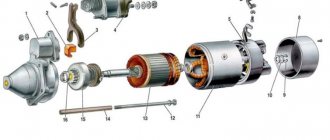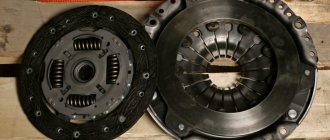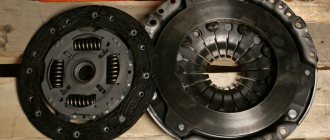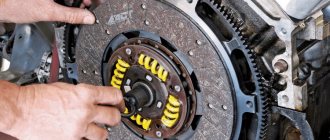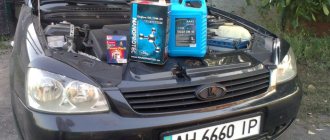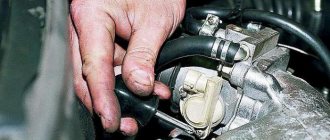A Lada running on methane, and indeed with LPG in general, is not a common occurrence. The VAZ 2170, also known as Priora, does not come from the factory with methane or other gas - this conversion is carried out by specialized companies, or by the craftsmen themselves. Methane is an economical fuel for Priora, but reviews say that gas stations are in short supply. Russian car owners are still in many cases skeptical about HBO, because they do not study this issue thoroughly, relying on stereotypes and outdated opinions. Not all owners install HBO on the Priora - it is believed that this way the car loses acceleration dynamics, and in the sedan body it is simply created in order to become someone’s first high-spirited car and leave an impression of ownership. Russian car owners are still in many cases skeptical about HBO, because they do not study this issue thoroughly, relying on stereotypes and outdated opinions.
Well, for a Priora in a station wagon, methane is well suited - the car literally calls for long family trips with a full trunk, and methane helps save money. As an example, already from the factory VAZ produces Vesta CNG - a modification of the serial version with factory-installed gas cylinder equipment that works with compressed natural gas - methane.
Methane is installed on the Priora yourself - and it is difficult to choose the manufacturer of the kit, because this is considered a good, serious investment in a car, in which it is better not to make mistakes. An important detail is that the installation of methane on a Priora should only be carried out by specialists, because this is not an ordinary modification of the car’s operating systems; This is a very serious alteration that requires both knowledge and skill.
Choosing LPG for Lada Priora
In total, there are 6 generations of gas-cylinder equipment: starting from the first, it has been continuously modified and improved to become an environmentally friendly and functional replacement for gasoline and diesel fuel. The most common is the fourth generation LPG (there is also a 4+ branch) - it is considered optimal in terms of the combination of one-time investments and payback period - and, as everyone knows, LPG is installed for the purpose of long-term savings.
The fourth generation is different in that everything is controlled by an analogue of the car's ECU - a gas control unit, and inside the cabin there is a button for switching from gasoline to gas and back. When choosing gas equipment for Priora, you should not save money and install the second or third generation - the savings will not be so serious, and it is not so easy to maintain or operate - after all, it is a slightly “outdated” development.
Examples of savings calculations in St. Petersburg
Let's calculate the difference in the cost of refueling gas and gasoline using two examples:
- From Nevsky Prospekt to the Ring Road and back in St. Petersburg 60 km. Let's take this distance as the daily mileage rate and calculate the benefit for the month.
- From St. Petersburg to Moscow - 710 km. Let's calculate how much you can save on a trip to Moscow and back.
Savings after switching to gas
| Engine | From Nevsky to Ring Road and back every day for one month | From St. Petersburg to Moscow and back | ||||
| Petrol | Propane | Saving | Petrol | Propane | Saving | |
| 1.6MT | 6,601 rub. | RUB 3,618 | RUB 2,983 | RUB 5,207 | RUB 2,854 | RUB 2,353 |
| 1.8MT | RUB 6,668 | RUB 3,651 | RUB 3,017 | RUB 5,261 | RUB 2,880 | RUB 2,380 |
| Prices in calculations: AI-95 - 37.42 rubles, CIS - 18.61 rubles. | ||||||
If you use LADA Priora rarely and travel short distances, the benefit will be insignificant. But if you spend more than an hour driving every day, HBO will pay for itself in the first year. Calculate how much you will save at the gas station based on your mileage in the savings calculator.
Tell your friends how to save money while driving:
Methane or propane-butane
Methane is pure natural gas - the same one that is supplied to residential apartments, and propane is, one might say, synthetic - a product of human processing of petroleum raw materials. Methane is very pure, but propane, just like gasoline sold at gas stations, is contaminated, only it is contaminated with another gas - butane, the percentage of which sharply reduces the vehicle's power reserve - the saturation of the gas mixture with butane makes it burn faster. Besides the fact that gas stations with methane are very rare (as an example, there are no more than 5 of them throughout Moscow), while gas stations with propane-butane are everywhere, they also have other differences:
- The cost of propane-butane gas equipment for Priora is cheaper, but the average price of 1 liter of methane is lower than propane-butane;
- LPG with methane is always larger (and this does not depend on the volume of the tank) in weight, size and “eats up” no less space in the trunk than a subwoofer, which is why it is only suitable for a station wagon body so that there is at least a little space left for luggage;
- Methane gas in a Priora can reduce acceleration dynamics by up to 20%, and propane-butane - only within 5-10%, which is almost imperceptible;
- Methane is a natural gas, it is very clean and environmentally friendly;
- The combination of natural gas methane and gasoline would be ideal for those who want to worry about the environment, but as long as gas stations with methane are not common, clean air in the city will remain a utopian dream.
SPECIALISTS ANSWER
If you compare gas with gasoline, the advantages of “blue fuel” are obvious, no matter how you look at it. A methane engine runs more smoothly, it is lubricated better, the oil film is not washed off from the cylinders, and deposits do not form in the combustion chamber. As a result, the resource of such a motor increases by about 30%. Methane produces fewer harmful emissions and reduces CO2 emissions to 120 gkm, which meets the future Euro-5 requirements.
It is not the Gods who burn the pots - this is probably the saying that car enthusiasts are guided by before installing LPG on their car with their own hands. Let's look at the installation stages and try to mention all the difficulties that may arise during the installation process.
Features of the transition of Priora to HBO: what you need to be prepared for
If you doubt whether you should switch to gas, imagine how much you will have to disassemble your car to install:
- Gas cylinder;
- Valves and reducer;
- Gas filling device;
- Sensors into the system;
- Gas hoses;
- Separate control unit.
Disassembly, installation, assembly, configuration can be completed in one day, and the equipment along with work can cost from 28 to 40 thousand rubles in a regular service, depending on the manufacturer of the gas equipment.
After this change, you need to register it in the traffic police database, and after that, during operation you will have to:
- Every 10-15 thousand km, change three gas purification filters: a filter in the gearbox, a solenoid valve filter and a fine vapor phase filter;
- Lose almost half of the free trunk volume or space for a spare wheel;
- Lose engine power by at least 10%;
- Go through an annual (or every 15,000 km) operation check and LPG settings;
- Get the opportunity to bring your car up to Euro 5 standards (with methane) and become the owner of a more environmentally friendly vehicle;
- Still, be glad that the mileage “from refueling to refueling” is becoming much longer;
- Warm up the car only with gasoline. By the way, it also starts on gasoline;
- Change the oil less often - no matter how much butane there is, it will not contaminate the oil;
- Delay the engine's "overhaul" period - less oil is killed, the risk of detonation is reduced (propane and methane are high-octane), and the oil layer is not washed off from the cylinder walls.
- Get used to the peculiarities of refilling - at first the cylinder will not be filled to the nominal volume. Trouble will come to those who are looking for methane gas stations - in search of one they will have to burn a lot of gasoline. And refueling with methane can take as long as 40 minutes.
The cylinders occupied the expanded niche of the spare wheel.
Starting next year, the body with a modified floor for cylinders will become the same for all versions of the Priora - both gasoline and gas. In ordinary cars, instead of the cylinders, there will be a plastic container for tools and other small items - plus a spare tire. The filling fitting is located next to the usual neck of the gas tank, under the general hatch.
The cruising range on methane is promised to be approximately 370 km. Taking into account also a full gas tank, you can declare up to 1000 km of mileage at one gas station. True, in normal mode the 1.6-liter engine runs on gasoline only when starting in cold weather, and after warming up the system itself switches to gas. It will also switch the engine to gasoline mode if the methane runs out. However, the driver can choose if necessary: there is a mode switch on the dashboard. At the same time, when running on gasoline, the engine complies with Euro-4 standards, while on gas it meets Euro-5 standards.
Consumption: comparison of gas and gasoline
On average, gasoline consumption on a Priora is 9-9.8 liters in the city (the calculation will be based on consumption when driving within the city) per 100 km. 1 liter of AI-92 costs about 42 rubles, that is, gasoline worth 3.78 rubles is burned per 1 km. The cost of 1 km of run with propane is approximately 1.12 rubles (at a cost of 25 rubles per 1 liter of propane-butane and a consumption of 4.5 l/100 km). In the case of methane, the average consumption is also approximately 4.5 liters per 100 km, only here: 1 liter of methane costs about 17-18 rubles (for calculation - 17). Then 1 liter of mileage will cost 0.76 rubles. Moscow prices.
Adding the cost of servicing the gas equipment, you will have to be disappointed: the installation will not pay for itself as quickly as you might expect by looking at the numbers. Car instructors often install LPG on the Priora, because every day the car covers a lot of kilometers, and fast acceleration is not so important to the student, then installing LPG quickly pays for itself - refueling becomes just a penny. Ordinary car enthusiasts install LPG in cases where they want to keep the car for several years.
Installation
The design of the car allows you to place a gas cylinder in the luggage compartment. The optimal solution is to use a toroidal container that can be installed in place of the spare wheel.
Professional installation of gas equipment requires a separate hatch, which is located in the standard refueling hatch. This ensures maximum comfort and ease of use of the system, which does not differ from the factory setting.
The equipment does not have a negative impact on the technical characteristics of the power unit. However, when operating it, you should promptly change the oil and adjust the valves on an 8-valve engine. This is due to the fact that the octane number of gas is higher than that of gasoline.
Two indicators are mounted on the dashboard of the car. One of them signals that the engine is running on gasoline during warm-up, and the second indicates a transition to gas. To diagnose the operation of HBO, a special connector is provided in the engine compartment.
Car color
Some motorists argue that the cost may directly depend on the color of the car. For example, a light model consumes much less than its dark counterpart, but this is far from a guarantee.
The influence of color has been proven by American scientists. They found that this was especially true during the warmer months.
When the car gets hot, it spends a lot of energy cooling the interior and, of course, fuel consumption increases
In the interiors of dark cars during the hot season, the temperature was several degrees higher than in light models. That is, the fuel consumption of the Priora station wagon (per hundred) in the summer will already be lower.
Why do we need special candles?
Not everyone understands what spark plugs are needed for gas equipment and why it is better to choose special elements of the ignition system.
Conventional spark plugs are designed to ignite a standard air-fuel mixture. If such parts are installed in a system where a mixture of air and gas burns, they will quickly fail.
We must not forget that the electrical resistance indicators of gas mixtures are much higher in comparison with gasoline compositions. Therefore, for effective ignition it is necessary to make a minimum gap between the electrodes. Otherwise, fire simply will not happen.
Having created special candles, manufacturing companies decided not to stop there.
Having asked developers which ignition system spark plugs would be best for gas equipment, most of them will probably answer that the favorites are parts using noble materials. This automatically increases their cost.
But there is a logical explanation. Special candles are needed for the reasons that combustion of the fuel mixture (gas and air) occurs at a higher temperature than when oxygen and gasoline ignite. And high temperature load significantly accelerates the wear of elements. Their service life decreases.
Potentially, ordinary gasoline spark plugs can work on a car with LPG. But their effectiveness will be significantly lower. Plus, they will quickly lose their service life.
To increase the durability of parts, manufacturers began to introduce higher quality raw materials into production. There are several main components that are often found in the composition of HBO candles.
- Iridium. The material is used in the manufacture of the central electrode. It turns out to be more resistant to wear and temperature. Plus ensures efficient ignition.
- Platinum. Used as soldering. Apply to side electrodes. Again, with the aim of increasing the service life.
- Copper. With its help, heat is better removed. Copper is used in the production of side electrode rods.
In some situations, design changes are made to the candles. Special protective layers are applied to the body. Thus, carbon deposits do not form so intensively on the surfaces of the spark plugs.
In practice, there are not many parts that can really effectively cope with the ignition of the gas-air mixture, as well as resist the resulting loads.
